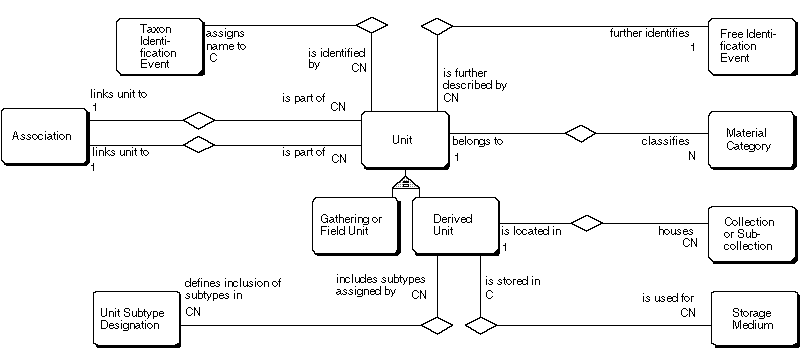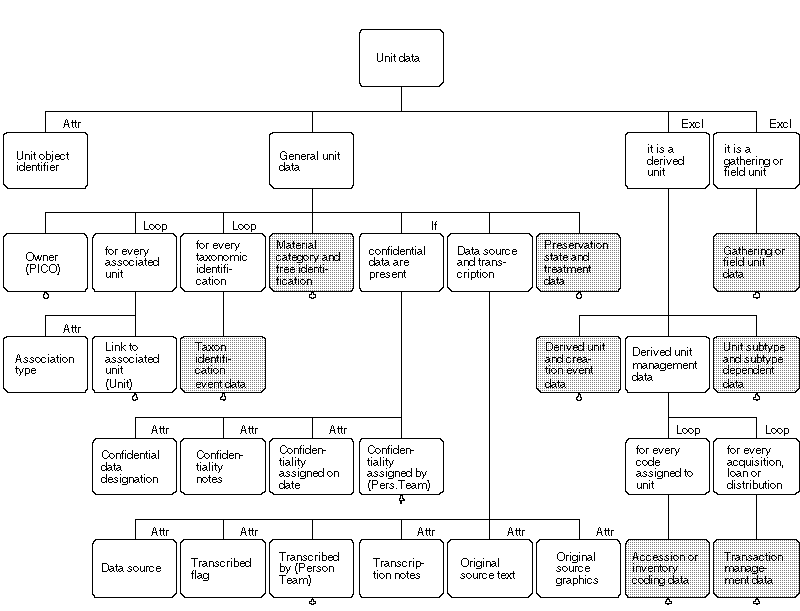
A unit is a physical object either in the field or in a specific collection. The term "specimen" can often be used as a synonym, however, it lacks a precise definition and consequently caused some confusion in the modelling process. The term "collection units" was used by Wilson (1993) in a modelling context, although with a different definition. The "collecting unit" in the ASC model (ASC 1992) is functionally analogous, although a fixed number of classes (subtypes) is used and the concept of the field unit is not included. The general context of the unit is given in Diagram 4. The following list provides the principal properties of the unit and its linked entities which are depicted in Diagram 14 and other diagrams specified in the text.

Diagram 14: Some unit-related entities (Entities)
Diagram 15 provides an overview of unit data. Every unit can be uniquely identified by the unit object identifier. Unit data can be subdivided into general unit data, derived unit data, and gathering or field unit data (further specified in Diagram 11). Every unit in a collection must have an owner (PICO, see under Persons, Teams, Institutes, Companies), which is not necessarily identical with the permanent storage location (see also Diagram 23). For example, a permanent loan may be owned by one institution but stored and handled by another, which effectively acts as if it was the owner. Ownership of field units is but rarely specified.
For each link to an associated unit an association type may be specified (see Association of Units below). Taxonomic identification events are further detailed in Diagram 30, material category and free identifications in Diagram 20, and preservation state and treatments in Diagram 26.
Unit information may be classified to contain confidential data. For example, for a rare plant the information about the existence of the plant may be public, but the point co-ordinates and exact locality description should not be accessible. The confidential data designation determines which data are confidential, notes may be added to save remarks on the designation, and the date and person responsible for the assignment is important to verify the validity of the designation.
The data source refers to the way the information was recorded (either "direct data entry" for primary source, or "from existing label", "from fieldbook", "from index card", "from laboratory notes", etc. for transcriptions). If the recorded information was transcribed, the transcribed flag is set and the person responsible for the transcription may be recorded. Notes regarding the transcription, e.g. the assignment of modern area names to historic gathering sites, conversion of calendar dates, or illegible parts of a label, can be stored in the transcription notes. The original source graphic or original source text may be used to provide a view on the entire original information unaltered by transcription processes. Such attributes have been used in the South-eastern Regional Floristic Information System (R. R. Haynes, pers. comm.), where herbarium label information was scanned, transcribed into full text, and finally assigned to the respective attributes. The graphic information is also useful in the case of older specimens, where labels tend to disintegrate, or where the handwriting is important.

Diagram 15: Data related to units (overview)
The information related to derived units may be subdivided into the following data areas: derived unit and derived unit creation event data (Diagram 17), unit subtype and subtype dependent data (Diagram 19), accession or inventory coding data (Diagram 22), and transaction management data (Diagram 24).